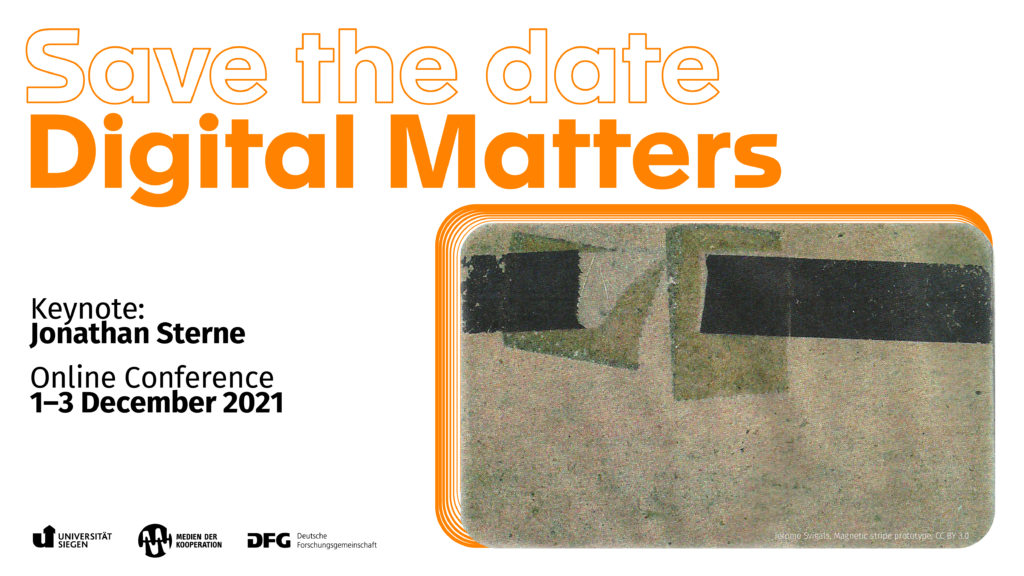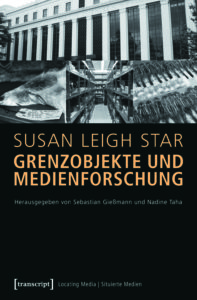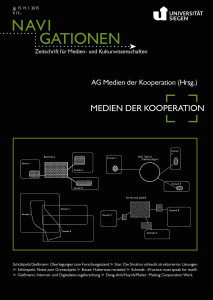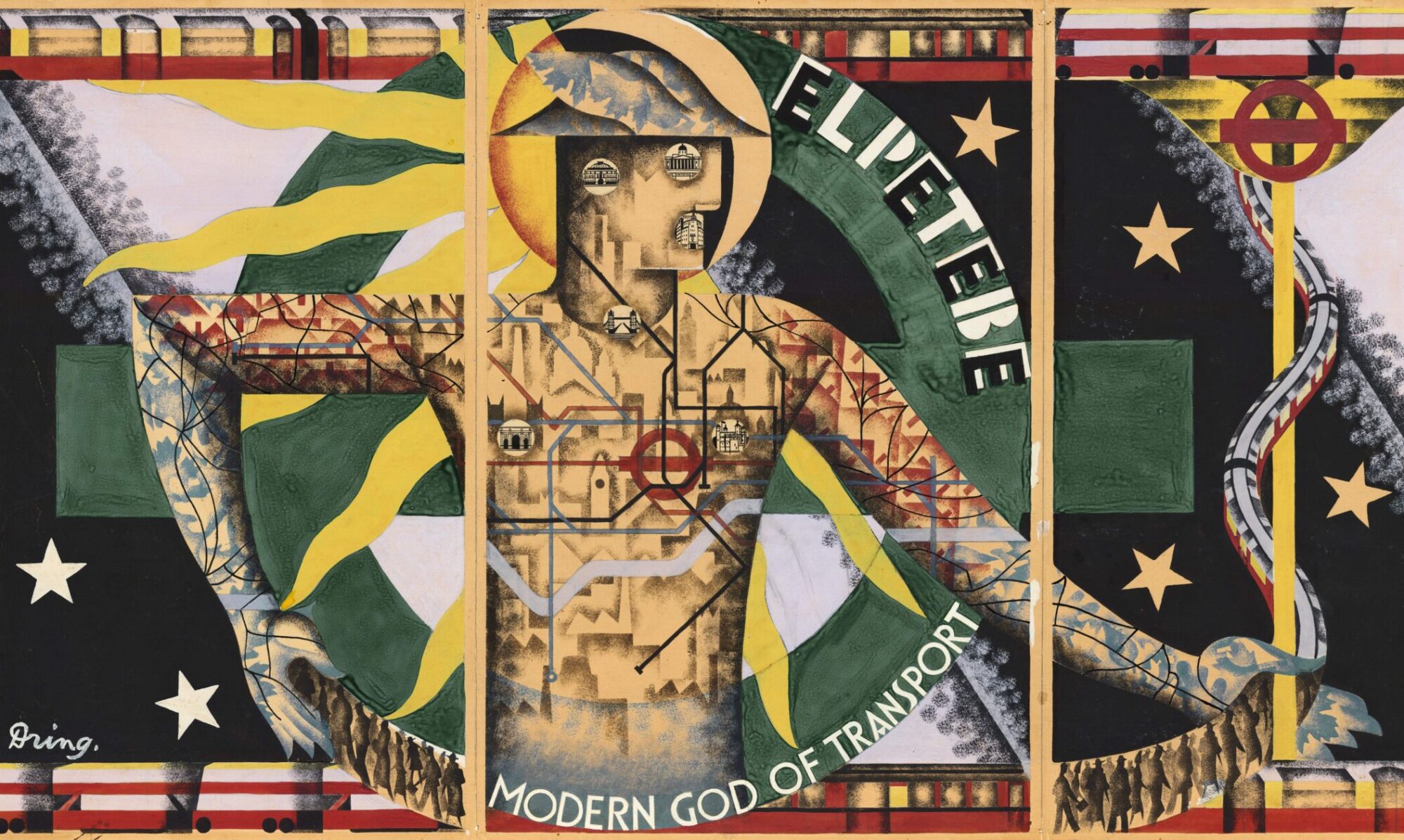Digital Matters
 In popular discussion digitality is increasingly equated with networked immateriality: disembodied algorithms float rhetorically in an ethereal cloud of big data. Think, for example, of the “digital edition” of the PlayStation 5 console, so called because it has no optical drive to read games, which must instead be downloaded. The implication is that the regular PS5 console is somehow not digital because its storage medium is visible to the unaided human eye. This presupposition of digital immateriality is not just a misconception to be corrected, but a productive site for interdisciplinary scholarly inquiry into media and data practices. In Digital Matters, historians, media theorists and information scholars come together for three days to examine the socio-material constituents of digital systems and artifacts. How and why did people come to deny the materiality of the digital? What can we learn by recovering it? What if we rethink digital materialities as ongoing cooperative accomplishments?
In popular discussion digitality is increasingly equated with networked immateriality: disembodied algorithms float rhetorically in an ethereal cloud of big data. Think, for example, of the “digital edition” of the PlayStation 5 console, so called because it has no optical drive to read games, which must instead be downloaded. The implication is that the regular PS5 console is somehow not digital because its storage medium is visible to the unaided human eye. This presupposition of digital immateriality is not just a misconception to be corrected, but a productive site for interdisciplinary scholarly inquiry into media and data practices. In Digital Matters, historians, media theorists and information scholars come together for three days to examine the socio-material constituents of digital systems and artifacts. How and why did people come to deny the materiality of the digital? What can we learn by recovering it? What if we rethink digital materialities as ongoing cooperative accomplishments?
The Digital Matters conference is going to take place December 1 – 3, 2021 at Siegen University’s Collaborative Research Center Media of Cooperation. Given the swift change in pandemic circumstances it will primarily be an online event.
Please check https://www.socialstudiesof.info/digitalmatters for the most up to date information on the program, and how to participate.
The conference is organized by Thomas Haigh (University of Wisconsin–Milwaukee & Siegen University), Valérie Schafer (University of Luxembourg), Axel Volmar (Siegen University) & Sebastian Giessmann (Siegen University).
December 1:
13:45: Conference introduction and welcome
Moderator: Valérie Schafer (C2DH, University of Luxembourg)
14:00-14:50: “Travelling machines,” Camille Paloque-Bergès (CNAM, Paris).
15:00-15:50: “Dimensions of Materiality,” Kyle Stine (Johns Hopkins University).
15:50-16:30: Break for virtual coffee.
Moderator: Miglè Bareikytè (Siegen University)
16:30-17:20: “Dance Notation: Grammars for Understanding and Controlling the Body,” Quinn DuPont (University College, Dublin).
17:30-18:20: “Modularity, Materiality, and the Political Order of the Stacks,” Jean-François Blanchette (University of California at Los Angeles).
December 2:
Moderator: Susanne Förster (Siegen University)
13:30-14:20. “Looking for Oil (and Finding It) in the History of Computing,” Cyrus Mody (Maastricht University).
14:30-15:20. “Digitality and Nature in the Anthropocene,” Felix Stalder (Zurich University of the Arts).
15:20-16:00: Break for virtual coffee.
Moderator: Sebastian Giessmann (Siegen University)
16:00-16:50: “The Great eBook Conspiracy: eReaders, Publishers, and Price Competition in the Early 2000s,” Gerardo Con Diaz (University of California at Davis).
17:00-17:50: “Rematerializing Money: Payment as Palimpsest,” Lana Swartz (University of Virginia) 17:50-18:30.
Break for virtual coffee or, for the adventurous, virtual cocktails.
18:30: Keynote lecture, “Some Species of Materiality.” Jonathan Sterne (McGill University). Moderated by Axel Volmar (Siegen University).
December 3:
Moderator: Thomas Haigh (University of Wisconsin–Milwaukee & Siegen University)
13:00-13:50. “The Politics of Technical Systems,” Bernhard Rieder (University of Amsterdam).
14:00-14:50. “Digital Materiality and Historical Innovation,” Ulf Hashagen (Deutsches Museum).
14:50-15:15. Break for virtual coffee.
Moderator: Tatjana Seitz (Siegen University)
15:15-16:15. “Web Materialities,” Valérie Schafer (C2DH, University of Luxembourg).
16:20-17:00. Closing roundtable featuring the organizers pondering lessons learned.
Standards Revisited

Thursday, 24 January 2019, University of Siegen
Herrengarten 3, 57072 Siegen, room AH 217/218
13:15 Opening Remarks: Standards Revisited
Sebastian Gießmann (University of Siegen) / Nadine Taha (University of Siegen)
13:30 Anna Echterhölter (University of Vienna)
Red and Black Boxes: Standardization as Mesuroclasm in German New Guinea
14:30 Nadine Taha (University of Siegen)
George Eastman and the Calendar Reform
16:00 Geoffrey C. Bowker (University of California, Irvine)
Standard Time: Computers, Clocks and Turtles – via Zoom Conference
17:00 Lawrence Busch (Michigan State University)
Markets and Standards – via Zoom Conference
Friday, 25 January 2019
10:00 JoAnne Yates (MIT, Sloan School of Management)
A New Model for Standard Setting: How IETF became the Standards Body for the Internet
11:00 Thomas Haigh
(University of Wisconsin, Milwaukee / University of Siegen)
The Accidental Standard: How a Box Became an Industry
13:00 Sebastian Gießmann (University of Siegen)
Standardizing Digital Payments
14:00 Anne Helmond (University of Amsterdam)/ Fernando van der Vlist (University of Amsterdam / University of Siegen)
‘It’s Graphs All the Way Down’
Standards are not easy to come by. As infrastructural media they coordinate the social to an ever-growing extent, thus creating conditions of cooperation. Standards do so not just by their sociotechnical power, but also by public uptake and controversies that put their accountability into question. They can also be understood as engineering and bureaucratic media that form a basis and condition for cooperation.
Historically, practices of standardization can be traced back to antiquity, especially in the history of coins, writing, and measurements. But pre-modern standards were bound to flounder and dissipate. Early modern knowledge cultures – partly – realized standardization via hand-made scientific instruments that extended metrological chains. While pre-industrial attempts to standardize the aggregation of information in administrative forms have been limited in scale and scope, 19th century industrialization interconnected with nationalized politics extended the territories of standardization. Media infrastructures such as the postal service and telegraphy became transnational through their administration in international organizations and a legal foundation via international treaties. Scale and scope of – inherently political and normative – standards and metrologies were at the same time constitutive for colonial prospection and rule.
Computing has given rise to its own regimes and obsessions of non-governmental standardizing. While early digital computers were unique, the trajectories of standardization were then tied to governmental contract research, commercialization and its coordinative and delegative practices. Serial production and the diffusion of architectural norms became a matter of economic competition in the era of mainframe computing in organizations. In multiple ways both the networking of heterogeneous computers and the success of the IBM-compatible PC did create a pathway to “open standards” that made computers publicly accessible. In the transpacific and global arena of hardware and software production, hyper-standardization has been an issue ever since. This also involves the questions of formats that mediate bureaucratic processes, textual representation, visual and auditory perception, and digital audiovisuality. Formats thus have become standards that mediate digital practices in their own right, just like network protocols and Internet standards. In many ways, the ecology of the World Wide Web is an ecology due to its standardizing bodies, communities of practice, and institutions like the Internet Engineering Task Force (IETF) and the World Wide Web Consortium (W3C).
Our aim is to understand how standards generalize and universalize media technologies, and to ask: How do metrology, industrialization, and imperialism/colonialism intersect with standards? What is the relation between standards, digital media, and coordination? How to explain the longue durée, ecology, and the enduring power of standards to configure cooperation? What is the relation between standards, delegative power, scale, and scope of media?
Collaborative Research Center Media of Cooperation, University of Siegen CRC project A01: “Digital Network Technologies between Specialization and Generalization”
Zwischen Infrastrukturen und Öffentlichkeiten: Praktiken und Kontroversen digitaler Medien
Grenzobjekte und Medienforschung
 Susan Leigh Stars (1954–2010) Werk bewegt sich zwischen Infrastrukturforschung, Sozialtheorie, Wissenschaftsgeschichte, Ökologie und Feminismus. Die wegweisenden historischen und ethnografischen Texte der US-amerikanischen Technik- und Wissenschaftssoziologin liegen mit diesem Band erstmals gesammelt auf Deutsch vor. Ihre Arbeiten zu Grenzobjekten, Marginalität, Arbeit, Infrastrukturen und Praxisgemeinschaften werden interdisziplinär kommentiert und auf ihre medienwissenschaftliche Produktivität hin befragt.
Susan Leigh Stars (1954–2010) Werk bewegt sich zwischen Infrastrukturforschung, Sozialtheorie, Wissenschaftsgeschichte, Ökologie und Feminismus. Die wegweisenden historischen und ethnografischen Texte der US-amerikanischen Technik- und Wissenschaftssoziologin liegen mit diesem Band erstmals gesammelt auf Deutsch vor. Ihre Arbeiten zu Grenzobjekten, Marginalität, Arbeit, Infrastrukturen und Praxisgemeinschaften werden interdisziplinär kommentiert und auf ihre medienwissenschaftliche Produktivität hin befragt.
Mit Kommentaren von Geoffrey C. Bowker, Cora Bender, Ulrike Bergermann, Monika Dommann, Christine Hanke, Bernhard Nett, Jörg Potthast, Gabriele Schabacher, Cornelius Schubert, Erhard Schüttpelz und Jörg Strübing.
„Grenzobjekte und Medienforschung“ ist im Open Access verfügbar.
The Cooperation Coordination Riddle, according to Google Ngram
I was just looking up some etymological details concerning “cooperation” and “coordination.” Google Ngram still is a rather intransparent source, but using it along with the Oxford English Dictionary gives a nice quantitative vs. qualitative account. This blogpost comes without interpretation, but with an embedded ngram. Consider it just being a trace of my work (or Google’s).
Vier Thesen zur Plattformgesellschaft (2)
Die vier Thesen zur Plattformgesellschaft, die Michael Seemann und ich zur re:publica 2015 formuliert haben, waren nie statisch gedacht. Also sollen sie fortwährend an die aktuellen medienkulturellen und ökonomischen Gemengelagen angepasst werden. Denn die Diskussion um die Vermittlungsleistungen und den Charakter digitaler Sozialität hat gerade erst begonnnen.
In meinem Siegener Seminar „Was ist eine Plattform?“ im Wintersemester 2015/16 (PDF) standen weniger die historischen Netzwerkeffekte und Plattformökonomien im Vordergrund, um die es uns bei der re:publica ging. Vielmehr ging es um die neuen und neuesten „sozialen Medien“. Ob des Tempos der Entwicklung sind Plattformen wie Facebook und YouTube dabei schon „alte Medien“, WhatsApp aktueller Mainstream und Snapchat vorläufig das nächste heiße Ding. Durch den Vergleich vieler aktueller Plattformen und ihrer Nutzungspraktiken lässt sich nun eine etwas andere Systematisierung vornehmen, die nach den gemeinsamen Eigenschaften der aktuellen Social-Media-Plattformen fragt – also nach ihrem Charakter als neue Vermittler.
Was also ist eine Plattform, als soziales Medium? Eine Definition könnte folgendermaßen formuliert werden:
- Plattformen sind datenintensive Infrastrukturen, auf denen verschiedene soziale Welten unterschiedlicher Akteure zusammentreffen können, aber nicht müssen.
Ihre infrastrukturelle Veränderung folgt also den verschiedenen Praxisgemeinschaften, die eine Plattform gewissermaßen für sich „erobern“. Filter bubbles und Echokammern existieren neben Interaktionsformen, in denen heterogene Akteure aus verschiedenen sozialen Welten miteinander interagieren. Dabei ist die Vermittlung zwischen unterschiedlichen sozialen Welten ein diffiziler Prozess, der an Missverständnissen, kulturellen Unterschieden und soziotechnischen Störungen scheitern kann. - Plattformen zielen auf die Aggregation von Netzwerkeffekten, indem sie Netzwerkbildungen von vielen Akteuren (many-to-many) einen standardisierten Rahmen geben.
Dies klingt zwar vergleichsweise geradlinig, ist aber ein komplexer Prozess, da sowohl sich formierende Praxisgemeinschaften und Plattformfunktionalitäten nicht konstant bleiben, sondern wechselseitig verfertigt werden. Twitter ist dafür das beste Beispiel, seiner von der aktivistischen horizontalen Vernetzung zum globalen Nachrichtenmedium verlaufenen Karriere. Der standardisierte Rahmen ist oft Gegenstand von Nutzungskontroversen, die gerade die Modi der Netzwerkbildung beinhalten, wie etwa die mittlerweile eingeführte algorithmische Relevanzfilterung in der Twitter-Timeline zeigt. - Plattformen sind Orte soziotechnischer Kooperation, die Vertrauen, Kontrolle, Bewertung, Klassifikation und Standardisierung miteinander kombinieren. Sie sind infrastrukturelle und öffentliche „Medien der Kooperation“.
Die normale Kooperationsform auf Social-Media-Plattformen ist die einer „Kooperation ohne Konsens“, wie sie die Techniksoziologin Susan Leigh Star beschrieben hat. Selbst vergleichsweise geschlossene, normativ ähnlich eingestellte und kleine Praxisgemeinschaften können i.d.R. selten einen kompletten Konsens über ihre Vorgehensweise erzielen. Gemeinsames kooperatives Handeln wird deshalb zuallermeist über gemeinsam genutzte Werkzeuge – in diesem Fall die Plattformfunktionalitäten und andere Software – organisiert. Selten gibt es hierfür die ideale Lösung, vielmehr ist auch die Interaktion in Social Media durch eine „Struktur schlecht strukturierter Lösungen“ (Star) gekennzeichnet, die für Vertrauensbildung, Kontrolle, Bewertung und Klassifikation genutzt werden. - Plattformen entwickeln eine regulative Kraft auf die durch sie vernetzten Akteure, werden aber durch deren Nutzungspraktiken fortwährend transformiert. Teilweise versuchen sie, den Charakter neuer Institutionen anzunehmen.
Was in der Forschung oft als globale „Plattformpolitik“ diskutiert und v.a. anhand der Terms of Service problematisiert wird, ist in der alltäglichen Interaktion mit sozialen Medien eine deutlich komplexere Angelegenheit. Die Ko-Konstitution von Medienpraktiken und datenintensiver Infrastruktur lässt sich nicht als statisches Diagramm zeichnen. Jedoch setzen gerade die großen, quasi-monopolistisch agierenden Plattformen sehr gezielt globale Kooperationsbedingungen. Diese sind aber nicht der Ort eines neuen, politisch und v.a. ökonomisch bezifferbaren Mediendeterminismus. Vielmehr bleibt es eine medientheoretische Aufgabe, den nur stabil erscheinenden, vorläufigen Status der neuen Medienagenturen zu bestimmen, mitsamt ihres Anspruchs als Ort der neuen Öffentlichkeiten.
Denn der aktuelle Strukturwandel der (privatisierten) Öffentlichkeiten ist mitnichten abgeschlossen, und kann sogar in’s gemeinschaftliche Web 0.0 zurückführen, wie ein gleichnamiges Projekt des italienischen Street-Art-Künstlers Biancoshock zeigt:
Medienpraktiken der Koordination, Delegation und Registrierung/Identifizierung*
Wie könnte eine Neuperspektivierung der Mediengeschichte und Medienanalyse aussehen, die Praxis allen anderen Größen vorlagert und deshalb vor allem Produktions- und Arbeitsprozesse, und damit auch die Modi bürokratischer Datenverarbeitung als „visible“ und „invisible work“ in den Vordergrund rückt (Star 1999)? Diese „Rückseite“ der Medien ist durch die langjährige analytische Trennung von Produktions-, Distributions- und Rezeptionsvorgängen in der deutschsprachigen Medienwissenschaft i. d. R. vernachlässigt worden – oft zugunsten eines Schwerpunkts auf Rezeptionsfragen, der wiederum selten praxeologisch fundiert wurde. Ein dreizügiges begriffliches Angebot, mit dem die kulturtechnischen Basisfunktionen des speicherprogrammierten Computers – also das „Speichern“, „Bearbeiten“ und „Übertragen“ (Kittler 1986) – auf eine wesentlich heterogenere Welt digital vernetzter Medien übertragen worden sind, bietet für eine durch digitale Medieninteraktion geprägte Welt keinen adäquaten Rahmen mehr. Vielmehr hat sich mittlerweile die Erkenntnis der Akteur-Netzwerk-Theorie durchgesetzt, dass Akteure Skalierungsleistungen selber erbringen, deren Maßstabswechsel wiederum zu berücksichtigen sind (Latour 2007; Ribes 2014). „Medienpraktiken der Koordination, Delegation und Registrierung/Identifizierung*“ weiterlesen
Credit Card Mobilities
The Swiss Federal Archives have been publishing a video documentation of their „ICT@Admin“ conference. I had the privilege of being a part of this, so I include the video and abstract of my talk here. A complete documentation is also online, and the overall YouTube playlist is highly recommended.
CREDIT CARD MOBILITIES (Sebastian Gießmann, Siegen, March 26 2015)
The talk sketches out a praxeological history of the credit card, with an emphasis on its mediating qualities and operational status within bureaucratical frameworks. Temporal borrowing via credit card is regarded as a highly dynamic social technology that produces emergent topologies through distributed mobile payments. The formative years of the American credit card (1950-1975) are analyzed along with approaches from ethnomethodology (Harold Garfinkel) and actor network theory (Michel Callon). Cooperative media practices are key to understanding the relation between the administrative handling of „accounts“ and emerging social networks. This includes (1) Dining, traveling, and charging, (2) Accounting for trust and credit, (3) Mass mailing and advertising new ways of payment, (4) Building „co-opetitive“ platforms for networks and (5), the digital momentum of credit cards as immutable mobiles.
Navigationen – Medien der Kooperation
 In den letzten Wochen gab es noch den Feinschliff, nun liegt die aktuelle Ausgabe der Siegener Navigationen gedruckt vor. Das von Matthias Schäfer gestaltete Cover zeigt nicht nur die Grafiken, mit denen die Techniksoziologin Susan Leigh Star ihr Konzept der „Grenzobjekte“ erstmals gegenüber Informatikern erläuterte. Auf der Rückseite haben wir noch einen kleinen heutigen Einblick in diejenige Institution versteckt, der die berühmte historische Fallstudie Stars und James Griesemers gegolten hat – das Museum of Vertebrate Zoology der University of Berkeley.
In den letzten Wochen gab es noch den Feinschliff, nun liegt die aktuelle Ausgabe der Siegener Navigationen gedruckt vor. Das von Matthias Schäfer gestaltete Cover zeigt nicht nur die Grafiken, mit denen die Techniksoziologin Susan Leigh Star ihr Konzept der „Grenzobjekte“ erstmals gegenüber Informatikern erläuterte. Auf der Rückseite haben wir noch einen kleinen heutigen Einblick in diejenige Institution versteckt, der die berühmte historische Fallstudie Stars und James Griesemers gegolten hat – das Museum of Vertebrate Zoology der University of Berkeley.
[Update 9.7.2015: Mittlerweile ist der Volltext der Ausgabe als PDF auf dem Siegener OPUS-Publikationsserver verfügbar.]
Worum geht es in dem Heft, das eine von David Sittler besorgte deutsche Erstübersetzung von Susan Leigh Stars „The Structure of Ill-Structured Solutions“ bietet?
Die digital-vernetzten Medien erfordern neue Analysen, Theorien und
Geschichten. Sie verändern unseren Blick auf die Geschichte von
Infrastrukturen, Öffentlichkeiten und Medienpraktiken. Was wären Ansätze
für eine Medientheorie, die praktischen „skills“ des Mediengebrauchs,
seiner soziotechnischen Materialität und den bürokratischen wie
epistemischen Qualitäten der Medien gerecht wird? Die vorliegende
Ausgabe 1/2015 der Navigationen widmet sich Medien als kooperativ
bewerkstelligten Kooperationsbedingungen. Sie erbringen, so die These,
konstitutive Vermittlungsleistungen zwischen der Organisation von
Arbeit, Praktiken des Infrastrukturierens und der Genese von
Öffentlichkeiten in wechselseitiger Interaktion.u.a. mit Beiträgen von Erhard Schüttpelz, Sebastian Gießmann, Susan
Leigh Star, Heinrich Bosse und Kjeld Schmidt.Hrsg. von der AG „Medien der Kooperation“
Erhältlich beim Siegener Universitätsverlag universi.


